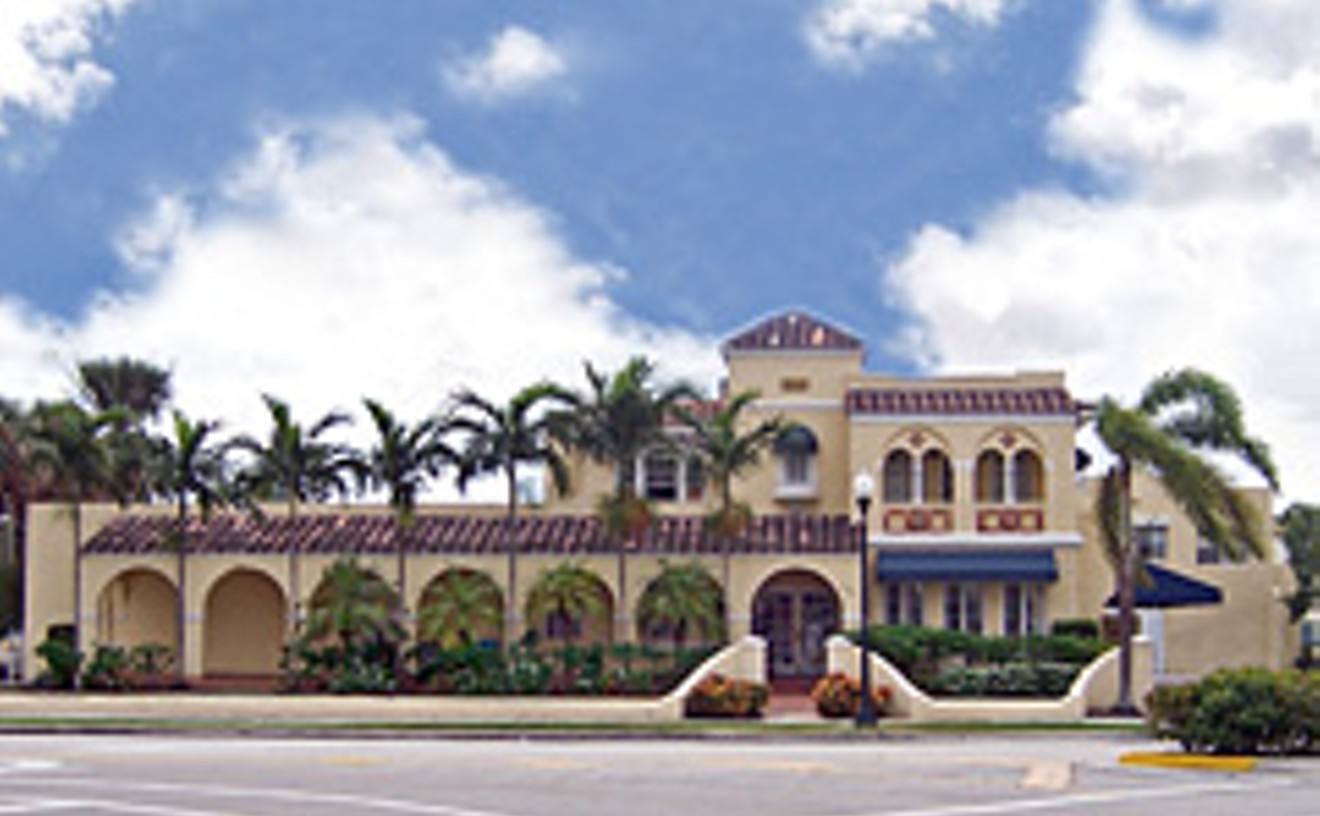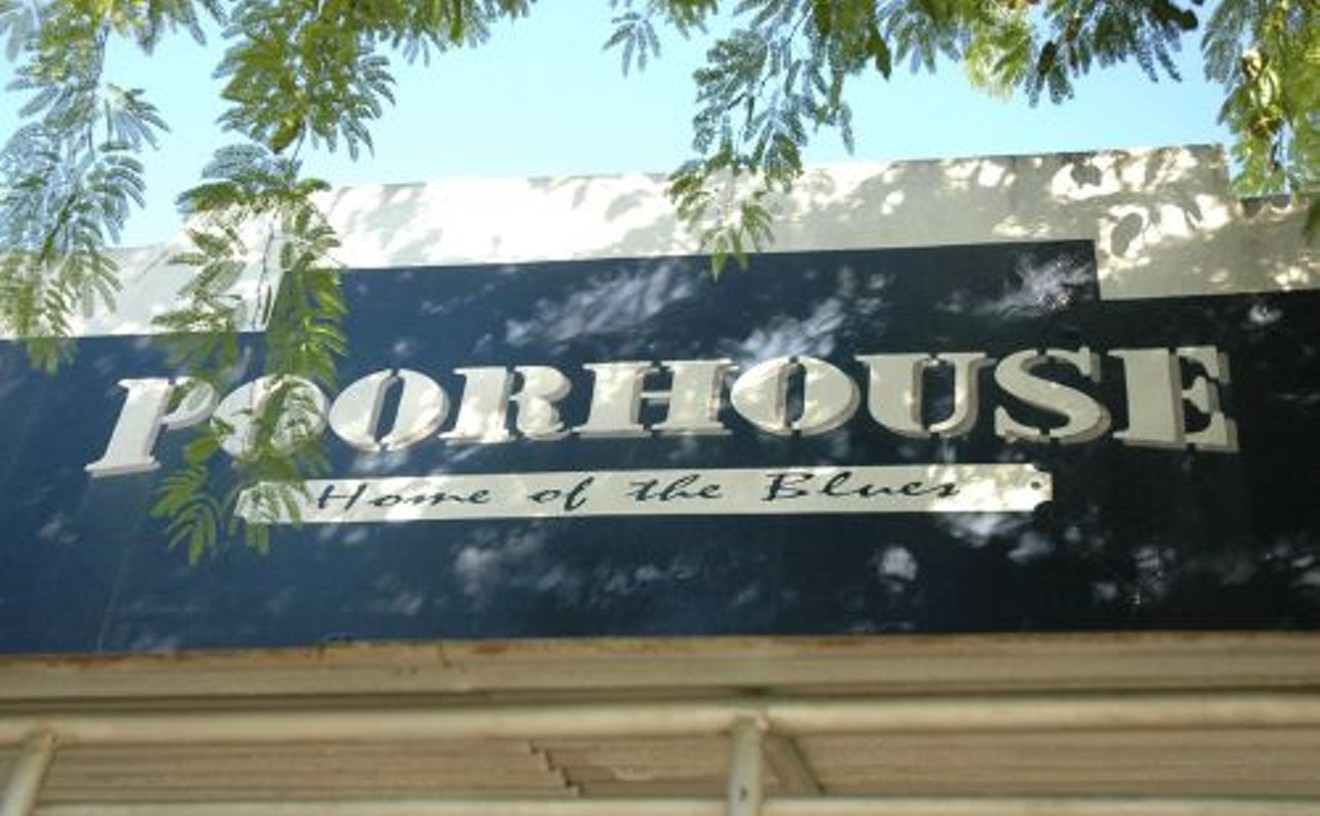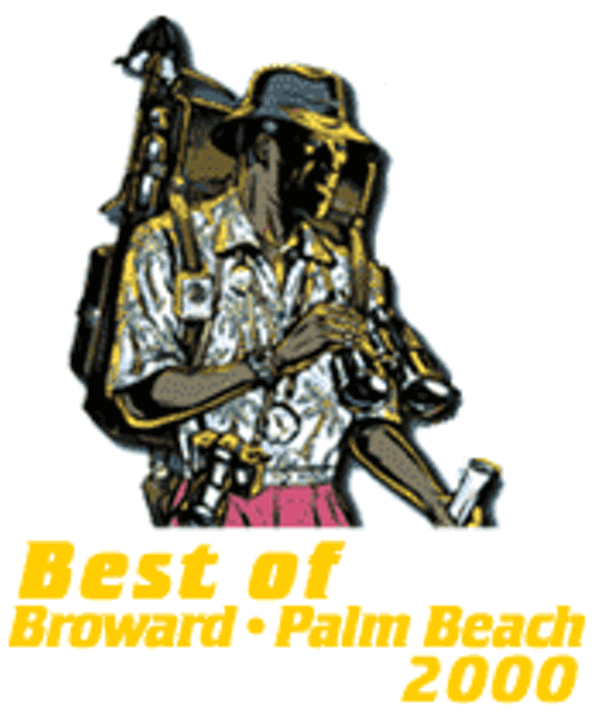Best Museum
Art and Culture Center of Hollywood

Granted, Fort Lauderdale's Museum of Art may have shaken off some of its stodginess, the Coral Springs Museum of Art may offer the best display space in the area, and the new Palm Beach Institute of Contemporary Art may be the most promising venue in South Florida. But right here, right now, the Art and Culture Center of Hollywood is the most exciting museum around. Credit curator of exhibitions Laurence Pamer for not being hampered by the awkward configuration of a building not originally designed as a museum, but credit him mostly for taking creative risks. In the past year or so, the center has been home to an eclectic array of exhibitions, including such quirky group shows as "The Symphony of Trees: Contemplations of Nature in the Abstract" and "Amalgam: Multi-Media Fusions by Four Florida Artists," not to mention the knockout "American Glass" show. Best of all, with the recent intentionally outrageous "Lowbrow: Up From the Underground" exhibition, Pamer proved he's not reluctant to offend people, which should be part of the job description for any curator.
- 1650 Harrison St., Hollywood, 33020 Map
- 954-921-3274
- www.artandculturecenter.org
Best Dive
Fort Lauderdale Saloon & Cafe
We probably don't need to say more than "65-cent drafts all day," but we will anyway. Two rooms greet the visitor, one with a faded, red-felt pool table and a jukebox posted on an ancient white-tile floor, and the other a barroom. The bar's surface is dark vinyl, the televisions above the bar are tuned to the National Enquirer channel, and shots are 75 cents. Longneck bottles of Budweiser are a buck, as are Hebrew National hot dogs, and a half-pound hamburger with all the trimmings is just $1.75. There are subs, soup and rolls, and a daily special that'll carry you to Georgia: all you can eat and drink for $6.95, until 6 p.m. After that, and until 2 a.m., it's $9.95. Lest you think that's all you can get, consider this: a 20-ounce "pint" of Guinness, Bass, or Harp is $2.50, and you can buy a bottle of pouilly-fuissé for $35. Note: Wear old clothes. You'll smell like stale beer and cigs when you emerge. If you emerge.
Best Dive
Fort Lauderdale Saloon & Cafe
We probably don't need to say more than "65-cent drafts all day," but we will anyway. Two rooms greet the visitor, one with a faded, red-felt pool table and a jukebox posted on an ancient white-tile floor, and the other a barroom. The bar's surface is dark vinyl, the televisions above the bar are tuned to the National Enquirer channel, and shots are 75 cents. Longneck bottles of Budweiser are a buck, as are Hebrew National hot dogs, and a half-pound hamburger with all the trimmings is just $1.75. There are subs, soup and rolls, and a daily special that'll carry you to Georgia: all you can eat and drink for $6.95, until 6 p.m. After that, and until 2 a.m., it's $9.95. Lest you think that's all you can get, consider this: a 20-ounce "pint" of Guinness, Bass, or Harp is $2.50, and you can buy a bottle of pouilly-fuissé for $35. Note: Wear old clothes. You'll smell like stale beer and cigs when you emerge. If you emerge.
Best Bar/Broward County
Poor House
Maybe most folks duck in here for their live-music fix, or maybe this bar's one of the last left where you can escape the coifed and lacquered minions of Himmarshee Street. Doesn't really matter. Fact is the Poor House reigns as a fine place to hunker down and drink. Maroon candles and tiny blue Christmas lights provide the front and back bars with the kind of low-key illumination you need after downing numerous pints. Cushy black barstools are plentiful, bartenders are attentive, and no one's trying to get you to buy some dumb-ass overpriced rose. The place gets packed on weekends with music and booze aficionados, but weeknights offer a more intimate, though no more sober, crowd. Instructions for visiting during the workweek: Go on a Tuesday evening. Pull up a stool. Pretend it's Friday and order shots of Rumplemintz with beer chasers. Mix well. Call in sick the next day.
Best Bar/Broward County
Poor House

Maybe most folks duck in here for their live-music fix, or maybe this bar's one of the last left where you can escape the coifed and lacquered minions of Himmarshee Street. Doesn't really matter. Fact is the Poor House reigns as a fine place to hunker down and drink. Maroon candles and tiny blue Christmas lights provide the front and back bars with the kind of low-key illumination you need after downing numerous pints. Cushy black barstools are plentiful, bartenders are attentive, and no one's trying to get you to buy some dumb-ass overpriced rose. The place gets packed on weekends with music and booze aficionados, but weeknights offer a more intimate, though no more sober, crowd. Instructions for visiting during the workweek: Go on a Tuesday evening. Pull up a stool. Pretend it's Friday and order shots of Rumplemintz with beer chasers. Mix well. Call in sick the next day.
- 110 SW Third Ave., Fort Lauderdale, 33312 Map
- 954-522-5145
- www.poorhousebar.com
Best Hard Rock Band
Hashbrown
South Florida is clogged with bands trying to pass off anger, volume, and beefy muscles as some kind of artistic statement. This path-of-least-resistance approach works part of the time, covering up weak spots with a sheen of shouts and bar chords. Enter Hashbrown, a Fort Lauderdale group that's not exactly subtle itself, but there's some real innovation in the band's decibel-heavy onslaught. Starting at slab level, drummer Steve Williams and bassist-singer Clarence Spencer form a perfectly symbiotic rhythm section, laying down guillotine-sharp grooves for guitarist Duncan Cameron to stretch his effects across. Adding turntable master Boogie Waters to the mix last year may have been Hashbrown's smartest move, with the smorgasbord of sound effects adding a new dimension to the rock-solid funk. Hashbrown may be grounded in the old-school machinery of Parliament/ Funkadelic and the like, but the group has obviously spent time plotting the future of the genre, too: Modernizing the sound puts Hashbrown in the same league as industrial-funk powerhouses like Tackhead and Little Axe. The band members are serious, too -- silly stage patter and self-congratulatory back-patting are kept to a minimum. Call it thinking man's hard rock.
Best Hard Rock Band
Hashbrown
South Florida is clogged with bands trying to pass off anger, volume, and beefy muscles as some kind of artistic statement. This path-of-least-resistance approach works part of the time, covering up weak spots with a sheen of shouts and bar chords. Enter Hashbrown, a Fort Lauderdale group that's not exactly subtle itself, but there's some real innovation in the band's decibel-heavy onslaught. Starting at slab level, drummer Steve Williams and bassist-singer Clarence Spencer form a perfectly symbiotic rhythm section, laying down guillotine-sharp grooves for guitarist Duncan Cameron to stretch his effects across. Adding turntable master Boogie Waters to the mix last year may have been Hashbrown's smartest move, with the smorgasbord of sound effects adding a new dimension to the rock-solid funk. Hashbrown may be grounded in the old-school machinery of Parliament/ Funkadelic and the like, but the group has obviously spent time plotting the future of the genre, too: Modernizing the sound puts Hashbrown in the same league as industrial-funk powerhouses like Tackhead and Little Axe. The band members are serious, too -- silly stage patter and self-congratulatory back-patting are kept to a minimum. Call it thinking man's hard rock.
Best Local Writer
John Dufresne
John Dufresne isn't really a Florida writer, even though he lives in Dania Beach and teaches at Florida International University. But Dufresne doesn't trade in detective novels suffused with only-in-South Florida weirdness like most of our local scribes. There are no hurricane-liberated rabid monkeys or drawbridge-jumping manatee lovers populating his stories. Dufresne's forte is something more enigmatic, more universal, more difficult, like true, monogamous love and whether it can truly exist. Or the substitution of everyday life and its frustrations with fictional representations or past-life remembrances. In his most recent novel, Love Warps the Mind a Little, Dufresne delightfully chronicles the hapless, bitter life of unsuccessful writer Lafayette Proulx. Laf's comrades in misery include his perpetually crying, soon-to-be-ex-wife, his cancer-ravaged psychiatrist mistress, and his Jeopardy!-obsessed coworker at Our Lady of the Sea fast-food fish joint. It's a funny, beguiling, and thoughtful contemplation of love, death, failure, and, well, life. And there's a bit of South Florida weirdness thrown in: The rest of Laf's family has relocated from Massachusetts to La Florida, where his brother worships Jesus and professional wrestling equally and his parents own a Canuck-catering hotel in Dania Beach.
Best Local Writer
John Dufresne
John Dufresne isn't really a Florida writer, even though he lives in Dania Beach and teaches at Florida International University. But Dufresne doesn't trade in detective novels suffused with only-in-South Florida weirdness like most of our local scribes. There are no hurricane-liberated rabid monkeys or drawbridge-jumping manatee lovers populating his stories. Dufresne's forte is something more enigmatic, more universal, more difficult, like true, monogamous love and whether it can truly exist. Or the substitution of everyday life and its frustrations with fictional representations or past-life remembrances. In his most recent novel, Love Warps the Mind a Little, Dufresne delightfully chronicles the hapless, bitter life of unsuccessful writer Lafayette Proulx. Laf's comrades in misery include his perpetually crying, soon-to-be-ex-wife, his cancer-ravaged psychiatrist mistress, and his Jeopardy!-obsessed coworker at Our Lady of the Sea fast-food fish joint. It's a funny, beguiling, and thoughtful contemplation of love, death, failure, and, well, life. And there's a bit of South Florida weirdness thrown in: The rest of Laf's family has relocated from Massachusetts to La Florida, where his brother worships Jesus and professional wrestling equally and his parents own a Canuck-catering hotel in Dania Beach.
Best Festival
Fort Lauderdale Cajun/Zydeco Crawfish Festival
What festival would be complete without plenty of head-sucking? We're talking about crawfish, of course, and the annual Cajun/ Zydeco Crawfish Festival comes with 35,000 pounds of the gnarly little crustaceans alive and kicking. Then throw in red beans and rice, crawfish bisque, étouffée, alligator, and muffulettas, all of it spicy. And there's enough gumbo at the festival to fill an Olympic-size swimming pool, too. When you're not busy spiking your tongue with the hot eats, you can get up and dance to the accordion-squeezing, foot-stomping zydeco music playing on stages complete with wooden dance floors. Bands like BeauSoleil, the Savoy Cajun Band, the VooDudes, the Déjà Vu Cajun Dance Band, and the Gumbo Junkyard kept the stadium rockin' in 1999, and if that wasn't enough to loosen you up, the fest offers red hurricanes and other assorted spirits being poured at a harrowing clip. For all you family stiffs, the place is tailor-made for kids, too, with children's activities, storytelling, and Cajun history lessons. Of course, it doesn't come cheap: Tickets cost $12 (will be $14 this year) at the gate (children age 12 and under free), and you have to pay for the food and beverages. Then again, the good things in life are rarely free.





